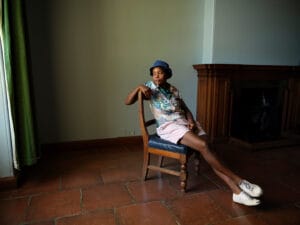Trending
- GLAAD Gaming Spotlight: Outerloop Games’ Chandana Ekanayake on Crafting Queer, Brown, and Bold Stories
- Healing Through Music: David Hernandez Releases “feel it all”
- The Okra Project Expands Nationwide with BetterHelp to Deliver Free Mental Health Care for Black Trans Communities
- Suni MF on Breaking Barriers in Hip-Hop and Winning Big at the BMI Awards
- GLAAD Amplifies Black Southern Queer Voices During LGBTQ Journalists Association Convention
- Queer Joy Shined at the 2025 MTV Video Music Awards
- WATCH: Dylan O’Brien and James Sweeney on ‘Twinless’ and Championing Original Queer Stories
- WATCH: Queer ‘Dancing with the Stars’ Cast Members Scott Hoying and Lauren Jauregui are Not Just Competing – They’re Changing Hearts and Minds













Choose from the complete list of GLAAD Accountability Profiles:
Jesse Singal
Journalist
—Wrote cover story for The Atlantic headlined “When Children Say They Are Trans: Hormones? Surgery? The choices are fraught—and there are no easy answers.” Singal raises questions in the article: “But when it comes to the question of physical interventions, this era has also brought fraught new challenges to many parents. Where is the line between not ‘feeling like’ a girl because society makes it difficult to be a girl and needing hormones to alleviate dysphoria that otherwise won’t go away? How can parents tell? How can they help their children gain access to the support and medical help they might need, while also keeping in mind that adolescence is, by definition, a time of fevered identity exploration?” Singal acknowledges “many” young people with gender dysphoria benefit from transition, then raises concern of “a small but vocal group of people” who say they did not: “Ignoring the diversity of these experiences and focusing only on those who were effectively ‘born in the wrong body’ could cause harm. That is the argument of a small but vocal group of men and women who have transitioned, only to return to their assigned sex.” Singal’s story was criticized for frontloading the rarer cases: “as the piece goes on—notably without a single happy, well-adjusted trans teen among its host of central characters for the first 9,000-plus words—it becomes apparent that certain voices and fears are privileged over others.” The Atlantic published follow-up letters from parents: “I write to you as a mother of a transgender son: This piece penned by you is highly problematic. It muddies the water for parents navigating this path of raising a trans child, and is damaging to our trans youth.” The Atlantic published additional articles to explain the concern for the transgender community, including one headlined: “The Loaded Language Shaping the Trans Conversation: To focus on “desisters”—people who experience gender dysphoria and then ultimately decide not to transition—is to focus on the rarest of cases, and to ignore the vastly more common experience of trans teens: that of being second-guessed.” Analysis from a sociologist at Columbia University explains: “The frames journalists use to discuss these controversial issues are themselves political and moral decisions, and ones of great consequence. They set the terms by which the public understands trans youth… a critical point is that these are rare cases: In my own conversations, even the most conservative clinicians told me they rarely, if ever, see someone make a full social and medical transition and then experience serious regret.” Singal’s story was cited in a legal brief filed by seven state attorneys general in a federal lawsuit seeking to roll back a trans person’s access to healthcare.
Singal addressed the criticism in a Medium post a few months after the story published: “These are eminently fair, good-faith critiques that I happen to disagree with: All I can say is that the decisions in question were a matter of careful and often-anguished collaboration with my editors as the piece was written, and that moving any one part up would have necessitated bumping some other part down. There are tradeoffs inherent to structuring a piece this large and complicated, and there’s no way to do it that won’t generate valid critiques from some party or another. I stand by the piece and the decisions we made in building it completely.”
—Admitted to misinterpreting a study on trans kids’ alleged desistance; continued to support exploring desistance despite its rarity: “the concept of desistance, on its own, should never be used as a justification for taking or recommending one course of action or another with a given gender dysphoric kid — as numerous clinicians have told me in my reporting on this endlessly fascinating and fraught subject, it’s vital to take an individualized approach, to get to know a kid and see where they’re at and what the sources of their distress are. Desistance is just one part of the puzzle. We shouldn’t ignore it, though, and it makes no sense to claim it’s a ‘myth.’
—Raised, without citation: “Trauma, particularly sexual trauma, can contribute to or exacerbate [gender] dysphoria in some patients.” Trauma, including sexual trauma, is unfortunately common, involving an estimated one in five women. There is no proven link between sexual trauma and sexual orientation or gender identity. Singal defended including the line in a Medium post: “I’ve encountered this link over and over and over in my dozens of hours of conversations with gender clinicians… Does that mean many or even most kids with gender dysphoria felt the dysphoria emerge in the immediate wake of a trauma? No. I bet most of the clinicians I spoke with would describe it as “rare” or “pretty rare.” But it still happens, and it’s still one piece of the puzzle that clinicians keep in mind when working with individual patients — and therefore an important thing for anyone with an interest in this subject to know about.”
—Amplified unproven theory of social contagion: “some anecdotal evidence suggests that social forces can play a role in a young person’s gender questioning. “I’ve been seeing this more frequently,” [psychologist] Laura Edwards-Leeper wrote in an email.” A widely cited study on this alleged influence was reissued with a correction reading in part: “Rapid-onset gender dysphoria (ROGD) is not a formal mental health diagnosis at this time. This report did not collect data from the adolescents and young adults or clinicians and therefore does not validate the phenomenon.”
—Wrote a defense of Dr. Kenneth Zucker in articles in The Cut in 2016. Zucker’s clinic was closed after accusations of practices to change gender-nonconforming mannerisms or identification to achieve a “cisgender goal,” and “curing“ children of their transgender identity. Singal described the internal review of Zucker’s methods as “a show trial” to appease “transgender activists.” Singal wrote: “Good prevailed over evil, in other words. Those innocent children would never suffer again. Zucker, his colleagues, and their many allies in the world of academic sex research see things differently. To them, the real scandal here is how CAMH responded to a sustained campaign of political pressure: by allowing a vital scientific question — vital not only to gender-dysphoric and transgender young people, but to anyone who is a parent or will one day become one — to be decided by activists on the basis of flimsy, anonymous allegations. They think the activists’ claims about the clinic are unfounded, and argue that the controversy has more to do with adult agendas than with genuine concern for gender-dysphoric children and youth.” The World Professional Association for Transgender Health (WPATH) reports that treatment that aims to “change a person’s gender identity and expression to become more congruent with sex assigned at birth has been attempted in the past without success. Such treatment is no longer considered ethical.”
The GLAAD Accountability Project catalogs anti-LGBTQ rhetoric and discriminatory actions of politicians, commentators, organization heads, religious leaders, and legal figures, who have used their platforms, influence and power to spread misinformation and harm LGBTQ people.
Related Posts
Donald Trump
47th Presidency 09.08.2025 In address to the Religious Liberty Commission, a group created by the…
Richard Grenell
—Said Pride events are, “embarrassing, to be honest.” He said Pride parades were “real fringe”…
Pete Hegseth
—Ordered the Navy to rename the USNS Harvey Milk, stripping the ship of the name…
Riley Gaines
Riley Gaines is an American former collegiate swimmer from Gallatin, Tennessee. In 2022, while swimming…
Share this
Join GLAAD and take action for acceptance.
ALERT Desk Incident Reporting
Our Picks
Suni MF on Breaking Barriers in Hip-Hop and Winning Big at the BMI Awards
GLAAD Amplifies Black Southern Queer Voices During LGBTQ Journalists Association Convention
How GLAAD is Combatting Censorship by Sending LGBTQ Books Straight to Capitol Hill
Bring Them Home: Deploying Our State National Guard for Political Purposes Endangers Public Safety
Topics
Follow Us
Don't Miss
GLAAD’s Darian Aaron Talks Faith, Race and Family in iHeartRadio Interview
“Show me how good it’s gonna get today, God. Dear universe, you have permission to…
Southern HIV/AIDS Awareness Day: Centering Equity and Action in the South
What’s At Stake at the Supreme Court in 2025-2026: Fast Facts
Forecast for Fabulous Part 2: All Slay, No Shade: Meteorologist Bryan Boggiano on Being Out, Neurodiverse, and Celebrating Icons in Southeast Alabama